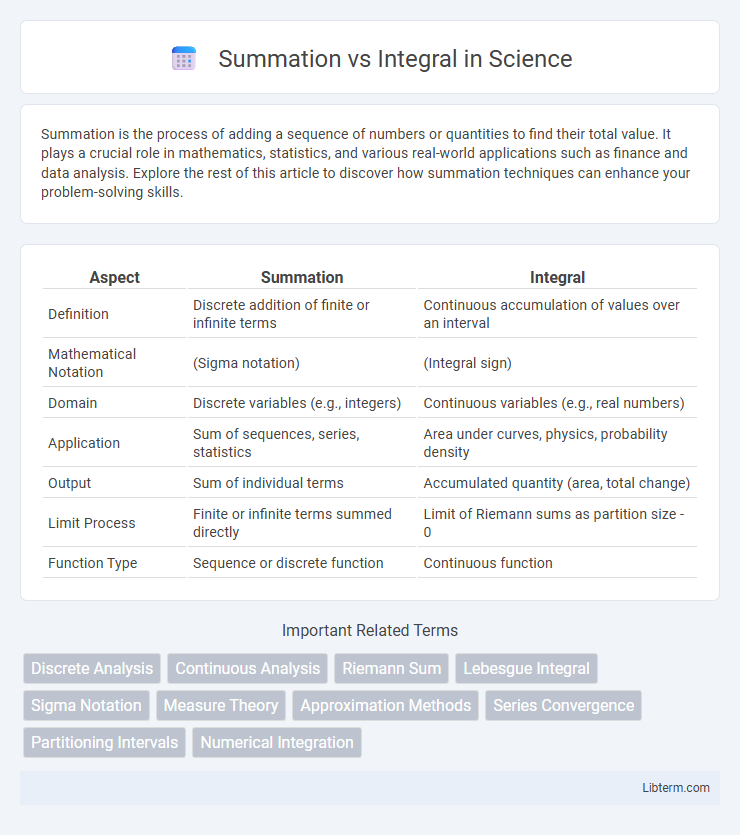Summation is the process of adding a sequence of numbers or quantities to find their total value. It plays a crucial role in mathematics, statistics, and various real-world applications such as finance and data analysis. Explore the rest of this article to discover how summation techniques can enhance your problem-solving skills.
Table of Comparison
| Aspect | Summation | Integral |
|---|---|---|
| Definition | Discrete addition of finite or infinite terms | Continuous accumulation of values over an interval |
| Mathematical Notation | (Sigma notation) | (Integral sign) |
| Domain | Discrete variables (e.g., integers) | Continuous variables (e.g., real numbers) |
| Application | Sum of sequences, series, statistics | Area under curves, physics, probability density |
| Output | Sum of individual terms | Accumulated quantity (area, total change) |
| Limit Process | Finite or infinite terms summed directly | Limit of Riemann sums as partition size - 0 |
| Function Type | Sequence or discrete function | Continuous function |
Introduction to Summation and Integral
Summation and integral are fundamental mathematical concepts used to aggregate values over discrete and continuous domains, respectively. Summation involves adding a sequence of numbers indexed by integers, often expressed with sigma notation (), while integrals represent the area under a curve or accumulation of quantities in continuous intervals, typically denoted by the integral symbol (). Understanding these operations is essential in calculus, enabling the transition from discrete sums to continuous accumulation and forming the foundation for advanced mathematical analysis in fields such as physics, engineering, and economics.
Defining Summation: Basics and Notation
Summation represents the process of adding a sequence of numbers, denoted by the sigma symbol (), where each term is indexed and evaluated within defined limits. It serves as a discrete counterpart to the integral, allowing the calculation of total quantities over finite or countable sets. The notation _{i=m}^n a_i succinctly captures the sum of terms a_i from index i = m to i = n.
Understanding Integrals: Concepts and Symbols
Integrals represent the continuous summation of infinitesimally small quantities, fundamentally different from the discrete addition in summation. The integral symbol originates from an elongated S, signifying the sum of function values over an interval. Understanding integrals involves grasping concepts like limits, area under curves, and the Fundamental Theorem of Calculus, which links differentiation and integration.
Key Differences: Summation vs Integral
Summation calculates the discrete total of a finite or countably infinite set of values, while an integral measures the continuous accumulation of quantities over an interval. Summation operates on distinct points, often represented as S notation, whereas integration involves limits and infinitesimal intervals, symbolized by . The key difference lies in summation's discrete nature versus integration's continuous framework, crucial in applications like numerical analysis and calculus.
Mathematical Applications of Summation
Summation is a discrete mathematical tool used to calculate the total of finite or infinite sequences, playing a crucial role in series analysis, combinatorics, and algorithm complexity evaluation. It enables precise calculation of terms in discrete domains, such as counting problems, probability distributions, and finite difference methods in numerical analysis. Unlike integrals, summation handles distinct data points, making it essential for digital signal processing, statistical data aggregation, and discrete optimization problems.
Real-World Uses of Integrals
Integrals play a crucial role in real-world applications by calculating areas under curves, determining accumulated quantities such as distance traveled or total mass, and modeling continuous phenomena in physics, engineering, and economics. Unlike summation, which deals with discrete data points, integrals handle continuous data, making them essential for precise measurements in fluid dynamics, electrical circuits, and probability distributions. Their use in computing exact values for growth rates, optimization problems, and cost functions underlines their significance across scientific and industrial fields.
Transition from Discrete to Continuous: When to Use Each
Summation is used for discrete data points or when calculating the total of finite or countable sets, such as sums of sequences or series, while integrals are applied for continuous functions to find areas, volumes, or accumulations over intervals. The transition from summation to integration occurs when the number of discrete points increases infinitely and the interval between points approaches zero, making the sum approximate the integral. Applications in physics, probability, and engineering often dictate using summation for digital or sampled data and integration for smoothly varying phenomena.
Visualizing Summation and Integration
Visualizing summation involves representing discrete data points as stacked bars or dots along an axis, highlighting the total accumulation of values in a finite series. Integration is visualized as the area under a continuous curve on a graph, illustrating the accumulation of infinitely small quantities across an interval. The comparison emphasizes summation's role in discrete data aggregation versus integration's function in measuring continuous change.
Common Mistakes and Misconceptions
Summation and integrals both aggregate values but differ in application: summations handle discrete data points while integrals apply to continuous functions. A common misconception is treating summations as integrals without considering the discrete nature, leading to errors in approximation or interpretation. Another frequent mistake involves assuming integral properties, such as linearity or limits, directly apply to summations without adjustment for discrete intervals.
Conclusion: Choosing Between Summation and Integral
Choosing between summation and integral depends on the nature of the problem, with summation best suited for discrete data or finite sequences, while integrals are ideal for continuous functions and infinite domains. Summation provides exact results for finite sets, whereas integrals offer approximations that become more precise as the partition of the domain gets finer. In practical applications, combining both approaches often yields optimal solutions by utilizing summations for discrete components and integrals for continuous behavior.
Summation Infographic

 libterm.com
libterm.com